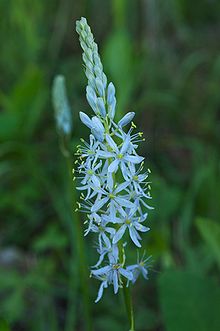

|
punct, italics
Tags: Mobile edit Mobile web edit Advanced mobile edit
|
added photo
|
||
| Line 14: | Line 14: | ||
== Description == |
== Description == |
||
The species produces [[inflorescence]]s up to half a meter tall from a [[bulb]] {{Convert|1–3|cm}} wide.<ref name=":0">{{Cite book|last=Elias|first=Thomas S.|url=https://www.worldcat.org/oclc/244766414|title=Edible Wild Plants: A North American Field Guide to Over 200 Natural Foods|last2=Dykeman|first2=Peter A.|publisher=[[Sterling Publishing|Sterling]]|year=2009|isbn=978-1-4027-6715-9|location=New York|pages=65|oclc=244766414|orig-year=1982}}</ref> It has a few leaves, each up to {{Convert|20–60|cm|abbr=on}} long.<ref name=":0" /> The flowers have light blue or whitish [[tepal]]s and yellow [[stamen|anthers]]. The green or brown capsule is up to a centimeter long<ref name="fna" /> and divided into three parts.<ref name=":0" /> |
The species produces [[inflorescence]]s up to half a meter tall from a [[bulb]] {{Convert|1–3|cm}} wide.<ref name=":0">{{Cite book|last=Elias|first=Thomas S.|url=https://www.worldcat.org/oclc/244766414|title=Edible Wild Plants: A North American Field Guide to Over 200 Natural Foods|last2=Dykeman|first2=Peter A.|publisher=[[Sterling Publishing|Sterling]]|year=2009|isbn=978-1-4027-6715-9|location=New York|pages=65|oclc=244766414|orig-year=1982}}</ref> It has a few leaves, each up to {{Convert|20–60|cm|abbr=on}} long.<ref name=":0" /> The flowers have light blue or whitish [[tepal]]s and yellow [[stamen|anthers]]. The green or brown capsule is up to a centimeter long<ref name="fna" /> and divided into three parts.<ref name=":0" /> |
||
[[File:Atlantis Camas.jpg|thumb|Atlantic camas ("wild hyacinth") flower]] |
|||
== Uses == |
== Uses == |
||
| Camassia scilloides | |
|---|---|

| |
| |
| Scientific classification | |
| Kingdom: | Plantae |
| Clade: | Tracheophytes |
| Clade: | Angiosperms |
| Clade: | Monocots |
| Order: | Asparagales |
| Family: | Asparagaceae |
| Subfamily: | Agavoideae |
| Genus: | Camassia |
| Species: |
C. scilloides
|
| Binomial name | |
| Camassia scilloides | |
| Synonyms[2] | |
|
Camassia esculenta | |
Camassia scilloides is a perennial herb known commonly as Atlantic camas, wild hyacinth,[1] and eastern camas.[3] It is native to the eastern half of North America, including Ontario and the eastern United States.[3]
The species produces inflorescences up to half a meter tall from a bulb 1–3 centimetres (0.39–1.18 in) wide.[4] It has a few leaves, each up to 20–60 cm (7.9–23.6 in) long.[4] The flowers have light blue or whitish tepals and yellow anthers. The green or brown capsule is up to a centimeter long[3] and divided into three parts.[4]

Native American groups used the bulbs for food, eating them raw, baked, roasted, boiled, or dried.[5] They can be used in place of potatoes, but could possibly be confused for poisonous deathcamas.[4]
The superseded name Camassia esculenta (Ker Gawl.) B.L.Rob. (nom. illeg.)[6] should not be confused with Camassia esculenta (Nutt.) Lindl., a superseded name for Camassia quamash subsp. quamash.[7]
| Camassia scilloides |
|
|---|---|
This Asparagaceae article is a stub. You can help Wikipedia by expanding it. |